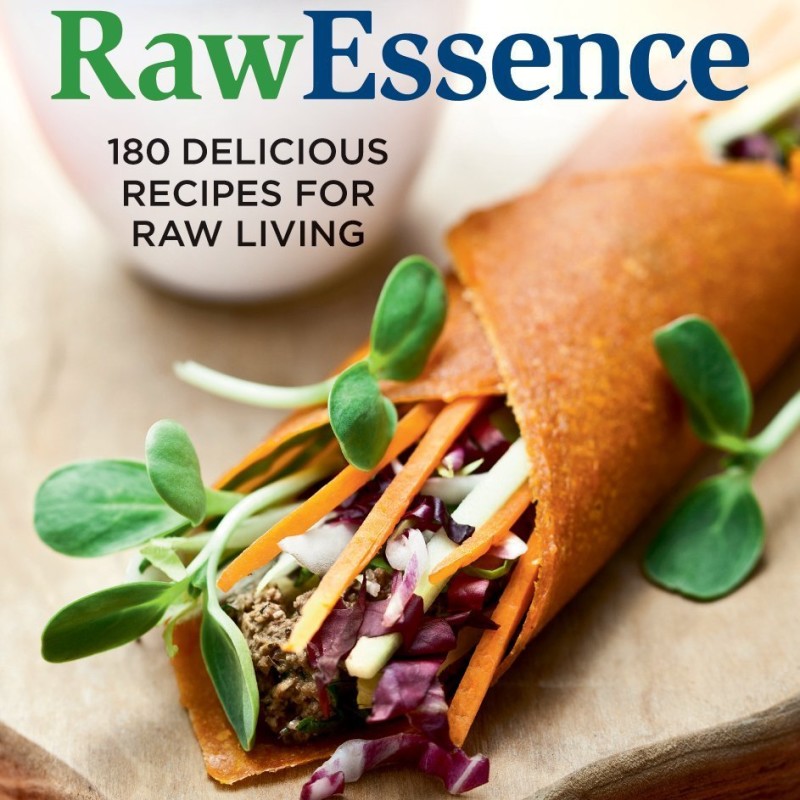Raw Foods
I think I’ve mentioned here before that we are not raw foodists in our home. That is, we don’t believe that all, or even most, of our food needs to be raw. However, we do believe that ‘most everyone can benefit from incorporating more raw foods into our diets, as the enzymes are beneficial and, often, the accessible vitamins and minerals are different from those in cooked foods. So I like to check out raw food “cook”books, to see what else we can put into our diet. (Besides, these recipes are often just flat-out more creative than the same-old cooked foods we find in “everyday” cookbooks.)
RawEssence
So when I heard that RawEssence: 180 Delicious Recipes for Raw Living was on Robert Rose’s spring release list, I was intrigued, and eager to take a look at a review copy. I was not disappointed. Although, as I expected, not everything in here is “for me,” there is plenty of good stuff here.
First of all, the book is simply beautiful! The whole thing is in full color, and if every recipe is not pictured, certainly almost every recipe is. This goes a long way toward making the recipes far more appealing than their ingredient lists alone. Even the endpapers/inside covers have recipe images on them!
Because people don’t generally eat raw grains, an added advantage of a raw “cook”book (it always feels weird calling it that) is that most, if not all, of these recipes are gluten-free. That means I can eat them all. Also, I don’t think there is soy is many of them. (A few do have traditional tamari soy sauce, but the book isn’t full of tofu-based recipes like a lot of vegetarian cookbooks.) Rather, there’s a heavy reliance on nutrient-dense foods, like nuts and coconut butter.
After an introductory section addressing the philosophy, many of the ingredients, and some basic techniques, the recipes are divided into chapters by recipe type. There are recipes for beverages, appetizers, soups, salads, spreads, fermentation, dehydration, main dishes, and desserts. For us, the main dishes are going to be one of the least-used, because we like (and seem to need) meat, and it’s the one category most likely to need special equipment. (Not a lot of special equipment is needed but, for instance, a spiralizer is used for creating vegetable noodles. Raw foodists will get a lot of use out of this, so it’s a worthy investment, but we won’t, so for us it isn’t.)
Frankly, the desserts are my favorites. I know, desserts are most people’s favorites, right? But when it comes to raw or paleo, or whatever other nutrient-dense whole-food-type diet, I like the options that are provided for adding some healthful foods into my diet through desserts or snacks. In other words, give me extra foods I can enjoy, that are also going to pack a nutritional punch. For the most part, these deliver on that. (A few use agave nectar, which is not as healthy as we’ve been led to believe. But for the most part, the ingredients used are wholesome, whole, and real.)
As an example, check out the recipe for Island Lime Pie below.

Island Lime Pie
Ingredients
Coco-Macadamia Crust
- 1/2 cup macadamia nuts
- 1 cup shredded coconut
- 2 1/2 Tbsp date paste or 3 chopped seedless dates
- 1/2 tsp alcohol-free vanilla essence
- 1/4 tsp sea salt
Avocado Mousse
- flesh of 2-3 avocados
- 3/4 cup freshly-squeezed lime or lemon juice
- 1/2 cup coconut butter
- 1/2 cup agave nectar
- 1/2 tsp alcohol-free vanilla essence
Frosting
- 1/4 cup water
- 1 Tbsp freshly-squeezed lime or lemon juice
- 1/2 cup macadamia nuts
- 2 tsp agave nectar
- 1/4 tsp alcohol-free vanilla essence
- 1/8 tsp sea salt
- 1 Tbsp coconut oil melted
Instructions
Coco-Macadamia Crust
- In food processor, chop macadamia nuts into small pieces.
- Add remaining ingredients and blend to obtain an evenly consistent crust that can be formed into a ball.
- Line the bottom and sides of a 9-inch pie plate with crust.
Avocado Mousse
- In food processor, combine all ingredients and blend to a smooth cream of even consistency. Pour into crust. Keep at room temperature while preparing frosting.
Frosting
- In blender, combine all ingredients except melted coconut oil and blend to a smooth cream of even consistency. This can take several minutes. If needed, add 1-2 Tbsp more water. While blender is running, incorporate melted coconut oil.
- Place mixture in a pastry bag with a narrow nozzle.
- Trace a spiral of frosting on the pie from the center to the rim of the pie plate. With a chopstick, trace a dozen lines in the frosting at regular intervals from the center to the rim to resemble a spider web.
TIPS
- Keeps 10 days in the refrigerator in an airtight container or for up to 4 months in the freezer.
- Garnish with lime slices and grated coconut, if desired.
Disclosure: Robert Rose provided me with a copy of the book to facilitate my review. As always, all opinions expressed here are entirely my own. The recipe for Island Lime Pie is reprinted with permission from the publisher.
Please note that if you order coconut products by clicking on any of my links and have never ordered from Tropical Traditions in the past, you will receive a free book on Virgin Coconut Oil, and I will receive a discount coupon for referring you. Amazon affiliate links may be present in this post, as well.

Leave a Reply